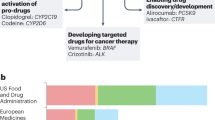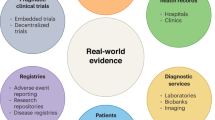Abstract
The potential to use biomarkers for identifying patients that are more likely to benefit or experience an adverse reaction in response to a given therapy, and thereby better match patients with therapies, is anticipated to have a major effect on both clinical practice and the development of new drugs and diagnostics. In this article, we consider current and emerging examples in which therapies are matched with specific patient population characteristics using clinical biomarkers — which we call stratified medicine — and discuss the implications of this approach to future product development strategies and market structures.
This is a preview of subscription content, access via your institution
Access options
Subscribe to this journal
Receive 12 print issues and online access
$209.00 per year
only $17.42 per issue
Buy this article
- Purchase on Springer Link
- Instant access to full article PDF
Prices may be subject to local taxes which are calculated during checkout





Similar content being viewed by others
References
Belli, F. et al. Vaccination of metastatic melanoma patients with autologous tumor-derived heat shock protein gp96-peptide complexes: clinical and immunologic findings. J. Clin. Oncol. 20, 4169–4180 (2002).
Capdeville, R., Buchdunger, E., Zimmermann, J. & Matter, A. Glivec (STI571, imatinib), a rationally developed, targeted anticancer drug. Nature Rev. Drug Discov. 1, 493–502 (2002).
Paoluzzi, L. et al. Influence of genetic variants in UGT1A1 and UGT1A9 on the in vivo glucuronidation of SN 38. J. Clin. Pharm. 44, 854–860 (2004).
Burstein, H. J. The distinctive nature of HER2-positive breast cancer. N. Engl. J. Med. 353, 1652–1654 (2005).
O'Neill, F. H. et al. Determinants of variable response to statin treatment in patients with refractory familial hypercholesterolemia. Arterioscler. Thromb. Vasc. Biol. 21, 832–837 (2001).
Ordovas, J. M. & Mooser, V. B. The APOE locus and the pharmacogenetics of lipid response. Genetics and molecular biology. Curr. Opin. Lipidol. 13, 113–117 (2002).
Chasman, D. I. et al. Pharmacogenetic study of statin therapy and cholesterol reduction. JAMA 291, 2821–2827 (2004).
PGx Health. Biomarker development. PGx Health web site [online], (2006).
Dowell, J. E. & Minna, J. D. Chasing mutations in the epidermal growth factor in lung cancer. N. Engl. J. Med. 352, 830–832 (2005)
Rhee, S. Y. et. al. HIV-1 protease and reverse-transcriptase mutations: correlations with antiretroviral therapy in subtype B isolates and implications for drug-resistance surveillance. J. Infect. Dis. 192, 456–465 (2005).
Roukos, D. H., Agnanti, N. J., Paraskevaidis, E. & Kappas, A. M. Approaching the dilemma between prophylactic bilateral mastectomy or oophorectomy for breast and ovarian cancer prevention in carriers of BRCA1 or BRCA2 mutations. Ann. Surg. Oncol. 9, 941–943 (2002).
DiMasi, J. A., Hansen, R. W. & Grabowski, H. G. The price of innovation: new estimates of drug development costs. J. Health Econ. 22,151–186 (2003).
Grabowski, H. G. & Vernon, J. Longer patents for increased generic competition in the US — the Waxman–Hatch Act after one decade. Pharmacoeconomics 10, 110–123 (1996).
Grabowski, H. G. & Vernon, J. The distribution of sales revenues from pharmaceutical innovation. Pharmacoeconomics 18 (Suppl. 1), 21–32 (2000).
Author information
Authors and Affiliations
Ethics declarations
Competing interests
This research has been supported by the MIT Center for Biomedical Innovation, which receives some of its funding from various biopharmaceutical industry sources. Through Co-Bio Consulting LLC, M.R.T. advises companies, universities and government agencies on biotechnology business and economic development strategies. E.R.B. has consulted for various biotechnology and pharmaceutical companies, federal government agencies, and health maintenance organizations. F.L.D. is Chairman of the Board of Directors of Alantos Pharmaceuticals and Member of the Board of Directors of Gene Logic and Nitromed. He is also scientific advisor to the Bayer HealthCare Group. M.R.T., E.R.B. and F.L.D. are also each uncompensated Special Government Employees at the Office of the Commissioner, U.S. Food and Drug Administration.
Glossary
- Biomarker
-
A characteristic that is objectively measured and evaluated as an indicator of normal biological processes, pathogenic processes or pharmacological responses to a therapeutic intervention.
- Clinical biomarker
-
A biomarker that associates a treatment to a patient sub-population that has historically showed a differential and substantial clinical response. These can be based on genotypes, proteins, metabonomic patterns, histology, imaging, physician clinical observations or even self-reported patient surveys.
- Esoteric diagnostics
-
High-value molecular tests such as genotyping, gene expression or other 'omics'-based tests.
- Gendanken experiment
-
A mental exercise that examines the essence of a hypothetical situation. Often called 'thought experiments' to distinguish them from physical experiments.
- Metabonomics
-
A systems-oriented approach involving the study of metabolic responses to drugs, diseases and environmental changes by surveying low-mass (<1,000 atomic units) molecules.
- Orphan drug
-
The Orphan Drug Act provides assistance and financial incentives for the development and approval of orphan drugs for diseases that affect patient populations of fewer than 200,000 people in the United States, including marketing exclusivity. Orphan drug exclusivity assures that no other sponsor will receive FDA marketing approval for the same drug for the same indication for 7 years after marketing approval of the innovator's product.
Rights and permissions
About this article
Cite this article
Trusheim, M., Berndt, E. & Douglas, F. Stratified medicine: strategic and economic implications of combining drugs and clinical biomarkers. Nat Rev Drug Discov 6, 287–293 (2007). https://doi.org/10.1038/nrd2251
Issue Date:
DOI: https://doi.org/10.1038/nrd2251
This article is cited by
-
Modular microfluidic system for on-chip extraction, preconcentration and detection of the cytokine biomarker IL-6 in biofluid
Scientific Reports (2022)
-
Generating real-world evidence from unstructured clinical notes to examine clinical utility of genetic tests: use case in BRCAness
BMC Medical Informatics and Decision Making (2021)
-
Deciphering Potential Correlations between New Biomarkers and Pattern Classification in Chinese Medicine by Bioinformatics: Two Examples of Rheumatoid Arthritis
Chinese Journal of Integrative Medicine (2021)
-
Limits of the social-benefit motive among high-risk patients: a field experiment on influenza vaccination behaviour
BMC Public Health (2020)
-
Unsupervised and supervised learning with neural network for human transcriptome analysis and cancer diagnosis
Scientific Reports (2020)



